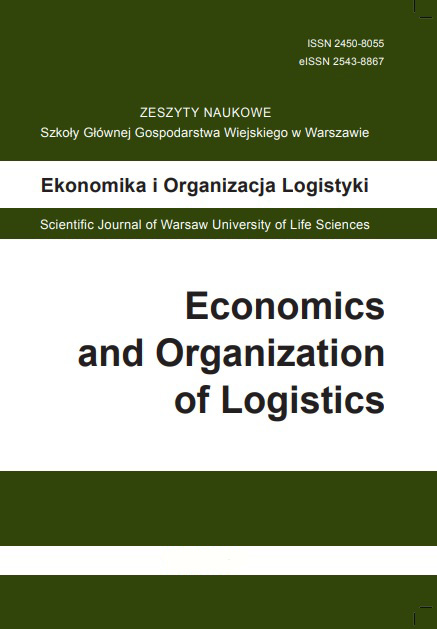Main Article Content
Article Details
Acharya, V. V., Cooley, T. F., Richardson, M. P., & Walter, I. (2011). Market failures and regulatory failures: Lessons from past and present financial crises.
Acharya, V. V., Pedersen, L. H., Philippon, T., & Richardson, M. P. (2010). Measuring Systemic Risk. AFA 2011 Denver Meetings Paper.
Adrian, T., & Brunnermeier, M. K. (2008). CoVaR. Federal Reserve Bank of New York. New York: Federal Reserve Bank of New York.
Bachelier, L. (1900). Theorie de la Speculation, Doctor Thesis, Annales Scientifiques Ecole Normale Sperieure III-17. The random character of stock market prices.
Baker, T., Vaidyanathan, J., & Ashley, N. (2012). A Data-Driven Inventory Control Policy for Cash Logistics Operations: An Exploratory Case Study Application at a Financial Institution. Decision Sciences, 44(1), 205.
Banulescu-Radu, D., Hurlin, C., Leymarie, J., & Scaillet, O. (2020, December). Backtesting Marginal Expected Shortfall and Related Systemic Risk Measures. Management Science, 67(9), 5301.
Basel Committee on Banking Supervision. (2018, July). Global systemically important banks: revised assessment methodology and the higher loss absorbency requirement. Retrieved 2023, from https://www.bis.org/bcbs/publ/d445.htm
Behn, M., Haselmann, R., & Vig, V. (2022). The limits of model-based regulation. The Journal of Finance, 77, 1635–1684.
Bianchi, M. L., & Sorrentino, A. M. (2020). Measuring covar: An empirical comparison. Computational Economics, 55, 511–528.
Black, F., & Scholes, M. (1973). The pricing of options and corporate liabilities. Journal of political economy, 81, 637–654.
Bloomberg L.P. (2021). Bloomberg Terminal. Retrieved 2021, from https://www.bloomberg.com/professional/solution/bloomberg-terminal/
Boucher, C. M., Danielsson, J., Kouontchou, P. S., & Maillet, B. B. (2014). Risk models-at-risk. Journal of Banking & Finance, 44, 72–92.
Box, G. E. (1979). Robustness in the strategy of scientific model building. In R. L. Launer, & G. N. Wilkinson (Eds.), Robustness in statistics (pp. 201–236). Research Triangle, North Carolina: Elsevier.
Brownlees, C. T., & Engle, R. (2012). Volatility, correlation and tails for systemic risk measurement. Available at SSRN, 1611229.
Bryant, R., Cintas, C., Wambugu, I., Kinai, A., Diriye, A., & Weldemariam, K. (2019). Evaluation of bias in sensitive personal information used to train financial models. 2019 IEEE Global Conference on Signal and Information Processing (GlobalSIP) (pp. 1–5). Ottawa: IEEE.
Castro, C., & Ferrari, S. (2014). Measuring and testing for the systemically important financial institutions. Journal of Empirical Finance, 25, 1–14.
Cedolin, M., Orhan, D., & Genevois, M. (2024). Statistical and Artificial Intelligence Based Forecasting Approaches for Cash Demand Problem of Automated Teller Machines . Journal of Engineering and Smart Systems, 12(1), 21.
Cesa, M. (2017). A brief history of quantitative finance. Probability, Uncertainty and Quantitative Risk, 2, 1–16.
Christoffersen, P., & Gonçalves, S. (2004). Estimation Risk in Financial Risk Management. CIRANO. Montreal: CIRANO.
Cifuentes, A., Hawas, F. J., & Chavarria, E. (2014). A Numerical Simulation Approach to Study Systemic Risk in Banking Systems. Available at SSRN 2539020.
Cobb, R. H., & Mills, H. D. (1990). Engineering software under statistical quality control. IEEE software, 7, 45–54.
Crouhy, M., Galai, D., & Mark, R. (1998). Model risk. Journal of Financial Engineering, 7, 267–288.
Danielsson, J., James, K. R., Valenzuela, M., & Zer, I. (2016). Can we prove a bank guilty of creating systemic risk? A minority report. Journal of Money, Credit and Banking, 48, 795–812.
Danielsson, J., James, K. R., Valenzuela, M., & Zer, I. (2016). Model risk of risk models. Journal of Financial Stability, 23, 79–91.
Derman, E. (1996). Model Risk: What are the assumptions made in using models to value securities and what are the consequent risks? RISK-LONDON-RISK MAGAZINE LIMITED-, 9, 34–38.
Dicuonzo, G., Galeone, G., Zappimbulso, E., Dell'Atti, V., & others. (2019). Risk management 4.0: The role of big data analytics in the bank sector. International Journal of Economics and Financial Issues, 9, 40–47.
DW. (2019, January). 2018: The worst year for stocks since financial crisis. Retrieved 2022, from https://www.dw.com/en/2018-the-worst-year-for-stocks-since-financial-crisis/a-46915652
European Central Bank. (2021). List of supervised banks. Retrieved 2021, from List of supervised banks: https://www.bankingsupervision.europa.eu/banking/list/html/index.en.html
EuSpRIG. (2013). The European Spreadsheet Risk Interest Group. Retrieved 2023, from https://eusprig.org/research-info/horror-stories/
Ferguson, N. (2008). The ascent of money: A financial history of the world. Penguin.
Fernandez-Perez, A., Fuertes, A.-M., & Miffre, J. (2023). The Negative Pricing of the May 2020 WTI Contract. The Energy Journal, 44, 119-142.
Garro, M. (2020). The evolution of model risk management processes. Journal of Risk Management in Financial Institutions, 13, 16–23.
Gilbert, E., & Strugnell, D. (2010). Does survivorship bias really matter? An empirical investigation into its effects on the mean reversion of share returns on the JSE (1984–2007). Investment Analysts Journal, 39, 31–42.
Glasserman, P. (2005). Measuring marginal risk contributions in credit portfolios. FDIC Center for Financial Research Working Paper.
Glasserman, P., & Xu, X. (2014). Robust risk measurement and model risk. Quantitative Finance, 14, 29–58.
Glasserman, P., Heidelberger, P., & Shahabuddin, P. (2000). Efficient Monte Carlo methods for value-at-risk. Yorktown Heights, NY: IBM Thomas J. Watson Research Division.
Goldberg, D. (1991). What every computer scientist should know about floating-point arithmetic. ACM computing surveys (CSUR), 23, 5–48.
Haldar, A., & Sethi, N. (2021). The news effect of COVID-19 on global financial market volatility. Buletin Ekonomi Moneter dan Perbankan, 24, 33–58.
Harkins, M. (2013). The Misperception of Risk. In Managing Risk and Information Security: Protect to Enable (pp. 15–25). Berkeley, CA: Apress.
Hendricks, D. (1996). Evaluation of value-at-risk models using historical data. Economic policy review, 2.
Holton, G. A. (2003). Value-at-Risk Theory and Practice. San Diego: Academic Press.
Hurd, T. R. (2016). Contagion!: Systemic Risk in Financial Networks. Cham: Springer.
Idier, J., Lamé, G., & Mésonnier, J.-S. (2013). How useful is the marginal expected shortfall for the measurement of systemic exposure? A practical assessment. ECB Working Paper, European Central Bank (ECB), Frankfurt a. M., 1546.
Irwin, N. (2015, August). Why the Stock Market Is So Turbulent. Retrieved 2022, from New York Times: https://www.nytimes.com/2015/08/25/upshot/why-global-financial-markets-are-going-crazy.html
Junior, L. S., & Franca, I. D. (2012). Correlation of financial markets in times of crisis. Physica A: Statistical Mechanics and its Applications, 391, 187–208.
Kato, T., Yoshiba, T., & others. (2000). Model risk and its control. Institute for Monetary and Economic Studies, Bank of Japan.
Kilkenny, M. F., & Robinson, K. M. (2018). Data quality: “Garbage in – garbage out”. Health Information Management Journal, 47, 103-105.
Klein, R. W., & Bawa, V. S. (1976). The effect of estimation risk on optimal portfolio choice. Journal of Financial Economics, 3, 215-231.
Koike, T., & Hofert, M. (2020). Markov chain monte carlo methods for estimating systemic risk allocations. Risks, 8, 6.
Kolman, J. (1999). LTCM speaks. Derivatives Strategy, 12–17.
Lamas, L., Gallejones, C. F., Moral, R. G., Cascales, J. G., & Calvo, J. (2014). Model Risk Management: Quantitative and qualitative aspects. Management Solutions.
Lehar, A. (2005). Measuring systemic risk: A risk management approach. Journal of Banking & Finance, 29, 2577–2603.
Lewellen, J., & Shanken, J. (2000). Estimation Risk, Market Efficiency, and the Predictability of Returns. NBER Working Papers, p. 7699.
Li, S., Chang, A., & Dave, P. (2015). Stock market suffers worst one-day drop since 2008. Retrieved 2022, from Los Angeles Times: https://www.latimes.com/business/la-fi-0822-financial-markets-20150821-story.html
Lowenstein, R. (2001). When genius failed: The rise and fall of Long-Term Capital Management. New York: Random House Publishing Group.
Madadi, N., Roudsari, A. H., Wong, K. Y., & Galankashi, M. R. (2013). Modeling and Simulation of a Bank Queuing System. (p. 209). Seoul, Korea (South): 2013 Fifth International Conference on Computational Intelligence, Modelling and Simulation.
McDonald, J. B. (1996). 14 Probability distributions for financial models. Handbook of Statistics, 14, 427–461.
Merton, R. C. (1974). On the pricing of corporate debt: The risk structure of interest rates. The Journal of finance, 29, 449–470.
Minderhoud, K. (2006). Systemic risk in the Dutch financial sector. De Economist, 154, 177–195.
Nievergelt, Y. (2000). Rounding errors to knock your stocks off. Mathematics Magazine, 73, 47.
Nouy, D. (2017). Gaming the rules or ruling the game?–How to deal with regulatory arbitrage. Shadow Banking, 53.
Pasieczna, A. H. (2019). Monte Carlo Simulation Approach to Calculate Value at Risk: Application to WIG20 and MWIG40. Financial Sciences. Nauki o Finansach, Sciendo, 24, 61-75.
Pasieczna, A. H. (2021). Model Risk of VaR and ES Using Monte Carlo: Study on Financial Institutions from Paris and Frankfurt Stock Exchanges. In Contemporary Trends and Challenges in Finance (pp. 75–85). Cham: Springer.
Pollack, L. (2013, January). A tempest in a spreadsheet. Retrieved 2021, from FInancial Times: https://www.ft.com/content/80bc5046-6ed2-30ef-b31a-bcbeac55d8bb
Powell, R. (2023). Six lessons from the collapse of LTCM. Retrieved 2023, from Timeline: https://www.timeline.co/blog/six-lessons-from-the-collapse-of-ltcm
QONTIGO. (2011). EURO STOXX Banks. Retrieved 2022, from https://qontigo.com/index/sx7e/
Savvides, S. (1994). Risk analysis in investment appraisal. Project Appraisal, 9, 3–18.
Sibbertsen, P., Stahl, G., & Luedtke, C. (2008). Measuring model risk. Journal of Risk Model Validation, 2, 65–82.
Siller, T. (2013). Measuring marginal risk contributions in credit portfolios. Quantitative Finance, 13, 1915–1923.
Simmonds, D. M. (2018). Complexity and the engineering of bug-free software. Proceedings of the International Conference on Frontiers in Education: Computer Science and Computer Engineering (FECS), (pp. 94–100).
Thomson, A. (2017). Google’s Sentiment Analyzer Thinks Being Gay Is Bad. Retrieved 2020, from Motherboard, Tech by Vice: https://www.vice.com/en/article/j5jmj8/google-artificial-intelligence-bias
Wagner, W., Fisher, E., & Pascual, P. (2010). Misunderstanding models in environmental and public health regulation. NYU Envtl. LJ, 18, 293.
Weatherall, J. (2013). It is not the maths that causes the crisis. Retrieved 2023, from Financial Times: https://www.ft.com/content/30fc4ece-760b-11e2-9891-00144feabdc0
Zhong, H., & Hamilton, M. (2023). Exploring gender and race biases in the NFT market. Finance Research Letters, 53, 103651.
Downloads
- Adam Rudzewicz, Anna Strychalska-Rudzewicz, Ireneusz Żuchowski, Ewolucja zakupów przez Internet w państwach Unii Europejskiej , Ekonomika i Organizacja Logistyki: Tom 9 Nr 2 (2024)
Możesz również Rozpocznij zaawansowane wyszukiwanie podobieństw dla tego artykułu.

Utwór dostępny jest na licencji Creative Commons Uznanie autorstwa – Użycie niekomercyjne 4.0 Międzynarodowe.





